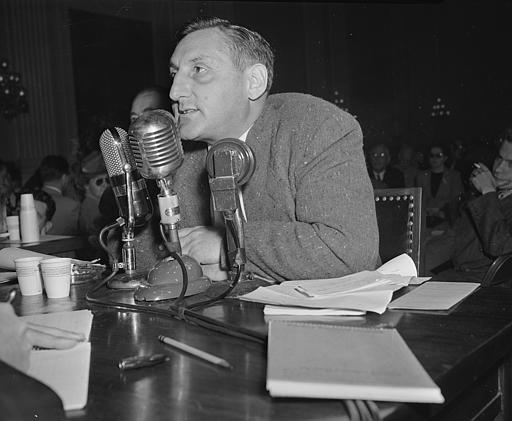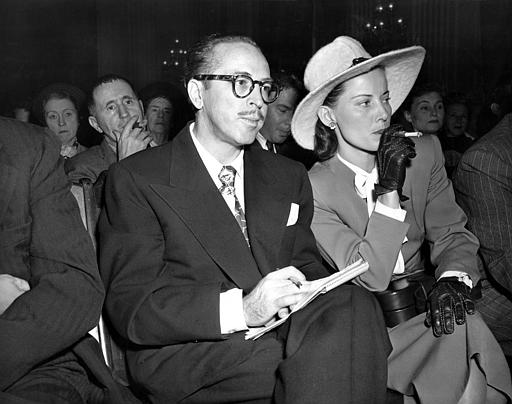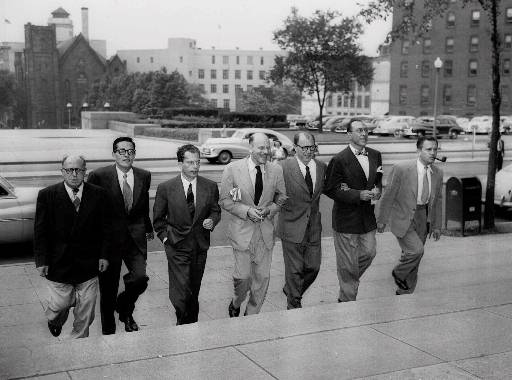In the context of the 1940s and 1950s, a blacklist was a list of persons whose opinions or associations were deemed politically inconvenient or commercially troublesome, making it hard for them to get work or, even worse, causing them to get fired. Blacklists were mostly associated with Hollywood and the movie industry, but they also had wide impact in other fields including radio, labor organizations, education, religion and government itself.
Putting people on blacklists based on their associations or beliefs came about after documented cases of Soviet spying made people fearful of communist infiltration that could undermine or even overthrow American government. (The most prominent spying case was that of American couple Julius and Ethel Rosenberg. The Rosenbergs were convicted in 1951 and later executed for conspiring to commit espionage for providing information to the Soviet Union, including on the U.S. nuclear weapons programs.)
Being on a blacklist caused people to lose their jobs
As historian Ellen Schrecker wrote in her book, “The Age of McCarthyism,” this era of targeting people for their beliefs and association was more notable for economic repression than political repression, though it was a horror for those who were wrongly imprisoned.
“…. Many prosecutions faltered on appeal and only a few foreign-born radicals were actually deported. Only Julius and Ethel Rosenberg were put to death; and of the roughly 150 people who went to prison, most were released within a year or two. Certainly compared to the horrors of Stalin's Russia, McCarthyism was not a drastic form of political repression. But it was an effective one.
The punishments were primarily economic. People lost their jobs… It is hard to come up with accurate statistics for the number of politically motivated dismissals during the McCarthy period, for both the employers and the people they fired tried to conceal what was happening — the former to protect themselves against charges of violating civil liberties, the latter to obtain future jobs. Yale Law School professor Ralph Brown, who conducted the most systematic survey of the economic damage of the McCarthy era, estimated that roughly ten thousand people lost their jobs. Such a figure may be low, as even Brown admits, for it does not include rejected applicants, people who resigned under duress, and the men and women who were ostensibly dismissed for other reasons. Still, it does suggest the scope of the economic sanctions ….”

John Howard Lawson, a Hollywood screenwriter, presses his face close to the microphone as he lashes out at the House Un-American Activities Committee in Washington, Oct. 27, 1947, during a tumultuous exchange which ended in his citation for contempt of Congress, a citation some say violated his First Amendment rights. He refused to answer questions as to whether he was or had ever been a member of the Communist party. (AP Photo/Beano Rollins)
Blacklists became prominent in Hollywood
Blacklists became particularly prominent in the industries investigated by the House Un-American Activities Committee (HUAC) for possible links to the Communist Party of the United States, most notably Hollywood film making.
The House committee was seeking to purge the country of any communist influences. The hearings concerning Hollywood were prompted when the Screen Writers Guild (SWG) became the writers’ official bargaining agent in the 1930s. The extreme right saw the unionization of writers as the first step toward the domination of the screen by communists.
In the 1940s, many American communists generally did not see themselves as defending the Soviet Union; rather, they were defending the “free world,” of which Russia was considered to be a part. Some joined the Communist Party because of the party’s social conscience at the time of fighting racism and the economic depression at home and fascism abroad.
in the 1930s and 1940s, communist screenwriters defended Stalin regime because, as U.S. screenwriter and author Albert Maltz once said, “There was very little available knowledge of the U.S.S.R.”
The Motion Picture Alliance for the Preservation of American Ideals (MPA), an organization that wanted to defend the movie industry against communist infiltration, encouraged the House Un-American Activities Committee to investigate communism in Hollywood. In May 1947, members of the motion picture alliance testified before the committee during closed hearings. As a result, many people in the entertainment industry were subpoenaed for the October 1947 hearings by the House committee. Those subpoenaed were considered either “friendly” or “unfriendly” witnesses.
House Un-American Activities Committee investigated potential communists
Before the hearings began, the “unfriendly” witnesses asserted that the investigation was a violation of their freedom of expression. A group of Hollywood liberals formed the Committee for the First Amendment (CFA) to lend support to the “unfriendly” witnesses.
In holding its hearings, the House Un-American Activities Committee had two main purposes. First, it intended to prove that the screen writers guild had members who were communists. Second, it hoped to show that these writers were able to insert subversive propaganda into Hollywood films. But Jack Warner of Warner Brothers, the first witness at the October hearings, assured =the committee that no “subversive propaganda” had ever been in any Warner Brothers films.
‘Hollywood Ten’ protested House investigation
When the first of the “unfriendly” witnesses, John Howard Lawson, asked permission to read a statement, committee chairman John Parnell Thomas insisted on reading it before granting permission. Outraged by Lawson’s planned critique of the committee, Thomas denied the request, and the interrogation was under way.
Lawson was gaveled into silence every time he started to say something beyond what he was asked. He grew angrier as Thomas’s gavel repeatedly cut him off. He was able, however, to make a few protests by saying, “The question of Communism is in no way related to this inquiry, which is an attempt to get control of the screen and to invade the basic rights of American citizens in all fields.” He refused to answer the question “Are you now or have you ever been a member of the Communist Party?”
Lawson was eventually cited for contempt of Congress for not answering questions. He and others who testified and tried to protest the committee’s work before being gaveled down and hauled off the stand became known as the “Hollywood Ten.”
The other nine were Albert Maltz and fellow screenwriters Dalton Trumbo, Alvah Bessie, Samuel Ornitz, Ring Lardner Jr., and Lester Cole; directors Herbert Biberman and Edward Dmytryk; and screenwriter and producer Adrian Scott.

In this photo, screenwriter Dalton Trumbo, left, and his wife, Cleo, listen from the audience as the chairman of the House Un-American Activities Committee (HUAC) announces a contempt citation against Trumbo at a hearing in Washington, D.C., Oct. 28, 1947 after he declined to say whether he is or has been a Communist. Trumbo served a prison sentence in 1950 and was blacklisted in the film industry. The beginning of the end of the Hollywood blacklist took place in 1960 when actor and producer Kirk Douglas gave screenwriting credit to Dalton Trumbo for the movie “Spartacus.” Unfortunately, after the blacklist was lifted most of those on it were not able to resume their careers in the entertainment industry. (AP File Photo)
Critics thought House committee violated First Amendment rights
Opponents of the contempt citations argued that HUAC had conducted its inquiry illegally by violating the constitutional rights of free speech and thought. In speaking out against the committee, Rep. Herman P. Eberharter of Pennsylvania asserted that the House had the choice of supporting either HUAC or free speech. “We cannot do both,” he said. “I cannot escape the conclusion . . . that the purpose of this committee was not to destroy an existent subversive threat in Hollywood, but to intimidate and control the movie industry."
'Hollywood Ten' and other put on blacklists
In November 1947, film executives and producers met in New York and issued the Waldorf Statement, which declared that they would not hire any member of the Hollywood Ten unless he was acquitted or had declared under oath that he was not a communist. They also would not knowingly hire anyone who was a communist. After being cited for contempt of Congress, the Hollywood Ten went to jail in 1950 once their appeals were exhausted.
During the second set of the committee’s hearings in 1951, many of those subpoenaed used the Fifth Amendment to avoid self-incrimination. Some of them gave names of those they believed to be communists.
Because of Hollywood blacklisting, some screenwriters had to leave the country to find work. Many had to resort to using pseudonyms to continue working.
The beginning of the end of the Hollywood blacklist took place in 1960 when actor and producer Kirk Douglas gave screenwriting credit to Dalton Trumbo for the movie “Spartacus.” Unfortunately, after the blacklist was lifted most of those on it were still not able to resume their careers in the entertainment industry.
FBI leaked communist sympathizers to employers
While FBI Director J. Edgar Hoover publicly renounced the “guilt by association” that followed many allegations of communist sympathy, his private actions were far different. FBI files and other historical research demonstrate that Hoover leaked information on potential sympathizers to like-minded media outlets and newspaper columnists as well as to Sen. Joseph McCarthy’s office and other GOP leaders. Many employers buckled to the pressure. For example, companies such as U.S. Steel and General Electric said they would who dismiss any employee who asserted Fifth Amendment rights in refusing to answer questions from a congressional committee about communist sympathies. Even lawyers who defended blacklisted clients were subjects to attacks and blacklisting themselves.
A study of FBI files from the McCarthy Era reached this conclusion:
“From February 1951 to March 1955, the FBI disseminated derogatory personal and political information to the employers of more than 400 schoolteachers and college professors; 200 city, county, and state government employees; 109 public utility workers; a handful of people employed by tax-exempt organizations ranging from the March of Dimes to the Damon Runyon Cancer Fund; and others. In all, the FBI targeted 810 American citizens for economic sanction, hoping to drive dissidents off public payrolls and into unemployment lines. Over half of all FBI Responsibilities Program actions were aimed at persons employed as teachers in public institutions…”
Blacklists targeted left-leaning radio broadcasters
In the early 1950s, radio was the dominant broadcast medium though television was rapidly ascending. Accordingly, McCarthy and his supporters paid particular attention to alleged leftist sympathies among broadcasters and their advertisers.
For example, the Society for Cinema Studies, in the Fall 2016 issue of its Cinema Journal, published an article describing the pressure faced by then-giant U.S. Steel Co. and its ad agency Batten, Barton, Durstine & Osborn (BBD&O) for its sponsorship of a popular radio program called “Theatre Guild of the Air.”
Other well-known journalists and commentators, such as William Shirer, lost their jobs during this period. Shirer started his career as a newspaper reporter, covering Charles Lindbergh’s flight among other stories before joining with famed broadcaster Edward R. Murrow to start the CBS radio network in Europe. Despite his distinguished work during World War II, in 1947 CBS president William Paley fired Shirer after the program’s soap-company sponsor dropped out after Shirer was labeled a Communist sympthizer. Shirer struggled for years until the 1960 publication of his acclaimed book on Hitler’s Germany, “The Rise and Fall of the Third Reich.”
Public employees screened for loyalties under Truman
In 1947, President Harry S. Truman began a program screening all federal employees of loyalty to the United States. Those who were members of or sympathized with communists, fascists or totalitarian organizations could be considered disloyal. To aid in making loyalty determinations, the U.S. Attorney General created a list of subversive organizations. The list was published in December 1947 and became became a de facto blacklist used by a wide variety of public and private groups to deny employment to people alleged to be associated with organizations on the list. Critics of the list say that political motives drove the initiative more than real fears of widespread disloyalty, and point out how criteria for adding a group to the list was arbitrary and uneven.
Many public officials in state and local governments joined the federal chorus in investigating and blacklisting individuals and organizations possibly associated with communism, often with little or no due process.
Educators on blacklists faced unwanted scrutiny
An example of the pressure placed on public school educators was in Scarsdale, New York, after a group of residents campaigned for a full investigation into alleged Communist influence in their schools. Among other things, the residents wanted books banned that were associated with “Communist sympathizers and apologists,” such as the author Howard Fast, who was later blacklisted and jailed for contempt of Congress during the House Un-American Activities Committee investigations.
The constant pressure by the Scarsdale group made national headlines. However, in this case, the school board and most local residents consistently resisted the censorship efforts of a small group.
In 1972, as reported by the New York Times, the city’s Board of Education took action to reinstate 31 teachers who lost their jobs during the McCarthy Era. Many had been dismissed for insubordination after refusing to answer questions about Communist Party membership.
Higher education institutions also were complicit in blacklisting. One prominent case went to the U.S. Supreme Court which in 1956 invalidated the firing of a Brooklyn College literature professor.
Harry Slochower was dismissed in 1952 after he invoked the Fifth Amendment during a Senate Internal Security Subcommittee hearing. The hearing was part of the broader investigations into alleged communist activities during the McCarthy Era.
Slochower had been questioned about his past membership in the Communist Party. By invoking the Fifth Amendment, he refused to answer questions on the grounds that his responses might incriminate him. Brooklyn College, citing a New York City charter provision, terminated his employment, arguing that invoking the Fifth Amendment was tantamount to an admission of guilt.
The Supreme Court, in a 5-4 decision, ruled that Slochower’s dismissal violated due process. The Court held that the mere invocation of the Fifth Amendment could not be used as a basis for dismissal without further evidence of wrongdoing.
Ironically, Slochower only briefly retained his job. According to his obituary in the New York Times, “He was reinstated with more than $40,000 in back pay but was suspended almost immediately on charges that he had made false statements under oath at the Senate hearing.”
Religious institutions weren’t spared from attacks
One of the most fascinating and shameless figures to emerge from the ranks of anti-Communist crusaders was J.B. Matthews. Born to a father described as a “fervent Methodist,” he championed civil rights and other left-wing causes, often associating with groups sympathetic to Stalinist Russia. At some point, he soured on communism and began compiling lists of alleged sympathizers. He became a well-known anti-Communist investigator. He reportedly once described Shirley Temple, then a child actress, as a “Communist stooge.”
After joining McCarthy’s staff, Matthews wrote an article in the American Mercury magazine titled “Reds in Our Churches” that accursed Protestant clergy of being the single largest group supporting communism in the U.S. This infuriated many mainstream religious leaders, and a deal was brokered, involving then-Vice President Richard Nixon, to get Matthews to resign from McCarthy’s staff.
This article was originally published in 2009 and written by Brandon R. Burnette. It was updated in July 2024 by Dennis Hetzel, a freelance writer and editor in Holden Beach, North Carolina. Hetzel is a former reporter, editor and publisher and was executive director of the Ohio News Media Association and Ohio Coalition for Open Government. He worked extensively on open government and free press issues throughout his career.

